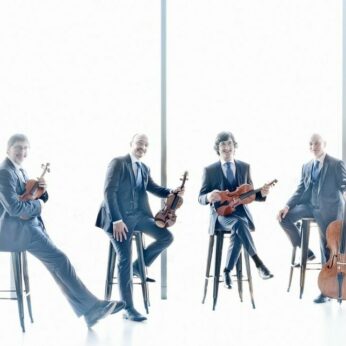Composer: Mieczyslaw Weinberg (b. 1919 - d. 1996)
Performance date: 27/06/2022
Venue: St. Brendan’s Church
Composition Year: 1940
Duration: 00:23:49
Recording Engineer: Simon Cullen, Ergodos
Instrumentation: 2vn, va, vc
Instrumentation Category:String Quartet
Artists:
Quatuor Danel (Marc Danel, Gilles Millet [violins], Vlad Bogdanas [viola], Yovan Markovitch [cello] -
[quartet]

Mieczysław Weinberg [1919-1996]
String Quartet No.2 Op.3/145 [1939/40 rev.1987]
1. Allegro
2. Andante
3. Allegretto
4. Presto
As a Polish Jew in Warsaw in 1939, Weinberg had two choices as the Nazi war machine rolled into Poland, escape or die. His situation mirrored that of today’s refugees from Eastern Ukraine walking a perilous path through the chaos of marauding invaders. As the USSR was simultaneously carving up Poland from the East, the new border was close enough for Weinberg to reach on foot, where he could easily have been sent straight to a Soviet concentration camp. It remains miraculous that he survived and was able to enrol as a composition student at Minsk Conservatoire (in today’s Belarus) under the distinguished composer Vasily Zolotaryov, who had himself studied under Balakirev and Rimsky-Korsakov.
Weinberg dedicated this Quartet to his mother and sister, whose fate was unknown to him at this time. Like the First Quartet, he returned to this early work nearly fifty years later, this time to create his First Chamber Symphony and to retouch some details of the original Quartet. Given the extraordinary journey Weinberg had made to reach Minsk, the opening of the first movement verges on the shocking. It is a light-hearted serenade straight from a Baroque concerto. The chromatic congestion of the First Quartet’s opening is replaced by a free and transparent texture and a mood of dancing gaiety. It is a substantial movement in sonata form, whose occasional darker moments are most apparent in the coda.
The Andante begins gently, a quiet song, with a steadfast pizzicato tread that gradually gathers momentum and complexity leading eventually to a light-hearted central dance. After this idea has been explored, the music sinks back to the opening song with the pizzicato rhythm leading the way. The following Scherzo is muted and acts both as a postlude to the Andante and a prelude to the extrovert Finale. This is announced with tremendous Beethoven style chords and away he goes with scarcely a pause for breath until the final shout.
Francis Humphrys
Copyright © 2024 West Cork Music. All rights reserved.
Designed and developed by Matrix Internet